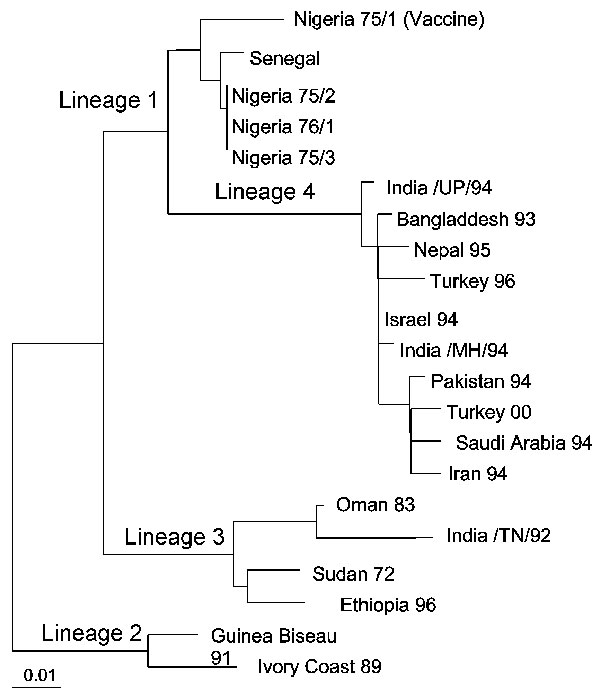Volume 8, Number 7—July 2002
Research
Prevalence, Distribution, and Host Range of Peste des petits ruminants virus, Turkey
Figure 2

Figure 2. Phylogenetic relationship of the Peste des petits ruminants viruses isolated in Turkey in 2000 to other virus isolates. The tree is based on partial sequence data from the fusion (F) protein gene (7) and was derived by using the PHYLIP DNADIST and FITCH programs (22). Branch lengths are proportional to the genetic distances between viruses and the hypothetical common ancestor at the nodes in the tree. The bar represents nucleotide substitutions per position.
References
- Taylor WP. The distribution and epidemiology of peste des petits ruminants. Prev Vet Med. 1984;2:157–66. DOIGoogle Scholar
- Awa DN, Njoya A, Ngo Tama AC. Economics of prophylaxis against peste des petits ruminants and gastrointestinal helminthosis in small ruminants in north Cameroon. Trop Anim Health Prod. 2000;32:391–403. DOIPubMedGoogle Scholar
- Roeder PL, Abraham G, Kenfe G, Barrett T. Peste des petits ruminants in Ethiopian goats. Trop Anim Health Prod. 1994;26:69–73. DOIPubMedGoogle Scholar
- Lefevre PC, Daillo A, Schenkel S, Hussein S, Staak G. Serological evidence of peste des petits ruminants in Jordan. Vet Rec. 1991;128:110.PubMedGoogle Scholar
- Abu-Elzein EME, Hassanien MM, Al-Afaleq AI, Abdelhadi MA, Honsawai FMJ. Isolation of peste des petits ruminants from goats in Saudi Arabia. Vet Rec. 1990;27:309.
- Shaila MS, Purushothaman V, Bhavasar D, Venugopal K, Venkatesan RA. Peste des petits ruminants of sheep in India. Vet Rec. 1989;125:602.PubMedGoogle Scholar
- Shaila MS, Shamaki D, Forsyth M, Diallo A, Goatley L, Kitching P, Geographic distribution and epidemiology of peste des petits ruminants viruses. Virus Res. 1996;43:149–53. DOIPubMedGoogle Scholar
- Barrett T. Morbilliviruses: dangers old and new. In: Smith GL, McCauley JW, Rowlands DJ. New challenges to health: the threat of virus infection. Society for General Microbiology, Symposium 60. Cambridge: Cambridge University Press; 2001. p. 155–78.
- Office International des Epizooties (OIE). OIE manual of standards for diagnostic tests and vaccines. List A and B diseases of mammals, birds and bees. Paris: The Office; 2000.
- Lefevre PJ, Diallo A. Peste des petits ruminants. [OIE]. Rev Sci Tech. 1990;9:951–65.
- Wosu LO. Current status of peste des petits ruminants (PPR) disease in small ruminants—a review article. Stud Res Vet Med. 1994;2:83–90.
- Anderson J, McKay JA. The detection of antibodies against peste des petits ruminants virus in cattle, sheep and goats and the possible implications for rinderpest control programmes. Epidemiol Infect. 1994;112:225–31. DOIPubMedGoogle Scholar
- Taylor WP. Protection of goats against peste des petits ruminants with attenuated rinderpest virus. Res Vet Sci. 1979;27:321–4.PubMedGoogle Scholar
- Dardiri AH, De Boer CJ, Hamdy FM. Response of American goats and cattle to peste des petit ruminants.Vet Lab Diagn 1976;337–44.
- Taylor WP, Abegunde A. The isolation of peste des petits ruminants virus from Nigerian sheep and goats. Res Vet Sci. 1979;26:94–6.PubMedGoogle Scholar
- Emergency Prevention System (EMPRES) for Transboundary Plant and Animal Pests and Diseases 2000; no. 13. Available from: URL://www.fao.org/empres
- Office International des Epizooties (OIE). OIE disease information 1999;12:137.
- Alcigir G, Vural SA, Toplu N. Türkiye'de kuzularda peste des petits ruminants virus enfeksiyonunun patomorfolojik ve immunohistolojik ilk tanimi. Ankara Universitesi Veteriner Fakültesi Dergisi. 1996;43:181–9.
- Tatar N. Koyun ve keçilerde küçük ruminantlarin vebasi ve sigir vebasi enfeksiyonlarinin serolojik ve virolojik olarak arastirilmasi [dissertation]. Ankara: Ankara Üniversitesi, Saglik Bilimleri Enstitusu; 1998.
- Peste des Petits Ruminants ELISA kit, Competitive Enzyme Immunoassay for Detection of Antibody to PPR Virus. Bench protocol, version PPR 1.0, January 1993. Joint FAO/IEAE Programme, Animal Production and Health. Pirbright, United Kingdom: World Reference Laboratory for Rinderpest; 1993.
- Forsyth M, Barrett T. Evaluation of polymerase chain reaction for the detection of rinderpest and peste des petits ruminants viruses for epiemiological studies. Virus Res. 1995;39:151–63. DOIPubMedGoogle Scholar
- Felsenstein J. PHYLIP – Phylogeny inference package. Cladistics. 1989;5:164–6.
- Al-Naeem A, Abu-Elzein EME, Al-Afaleq AI. Epizootiological aspects of peste des petits ruminants and rinderpest in sheep and goats in Saudi Arabia. [International Office of Epizooties]. Rev Sci Tech. 2000;19:855–8.PubMedGoogle Scholar
- Burgu I, Akca Y, Ozkul A. Rapid detection of rinderpest virus antigen using pig-anti-CDV-PO conjugate in cell culture. In: Proceedings of International Symposium on Morbillivirus infections. 12–13 June 1994, Hannover Veterinary School, Germany. Hannover: European Society for Veterinary Virology; 1995.
- Anderson J, McKay JA, Butcher RN. The use of monoclonal antibodies in competitive ELISA for the detection of antibodies to rinderpest and peste des ruminants viruses. In: Jeggo MH, editor. The sero-monitoring of rinderpest throughout Africa phase one. The proceedings of a final research co-ordination meeting of the FAO/IAEA/SIDA/OAU/IBAR/PARC Co-ordinated Research Programme. Ivory Coast. IAEA-Techdoc 1990;623:43–53.
- Furley CW, Taylor WP, Obi TU. An outbreak of peste des petits ruminants in a zoological collection. Vet Rec. 1987;121:443–7.PubMedGoogle Scholar
Page created: July 16, 2010
Page updated: July 16, 2010
Page reviewed: July 16, 2010
The conclusions, findings, and opinions expressed by authors contributing to this journal do not necessarily reflect the official position of the U.S. Department of Health and Human Services, the Public Health Service, the Centers for Disease Control and Prevention, or the authors' affiliated institutions. Use of trade names is for identification only and does not imply endorsement by any of the groups named above.